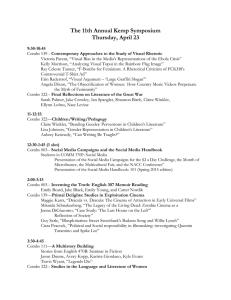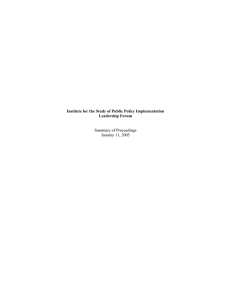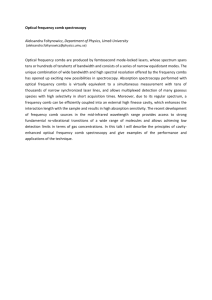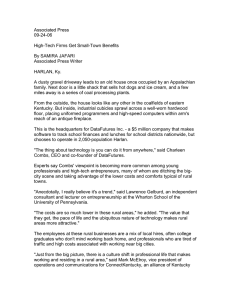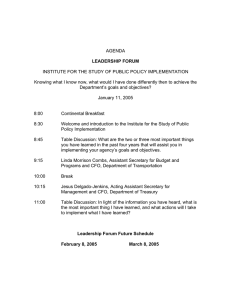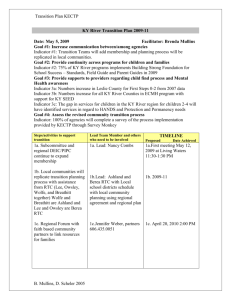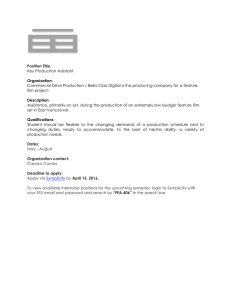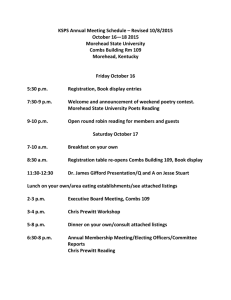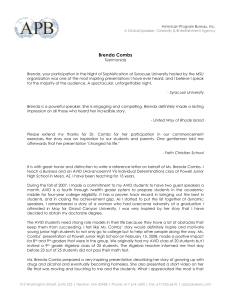CRITICAL CUT TO BE WATCHED THROUGHOUT THE ENTIRE PRESS RUN
advertisement
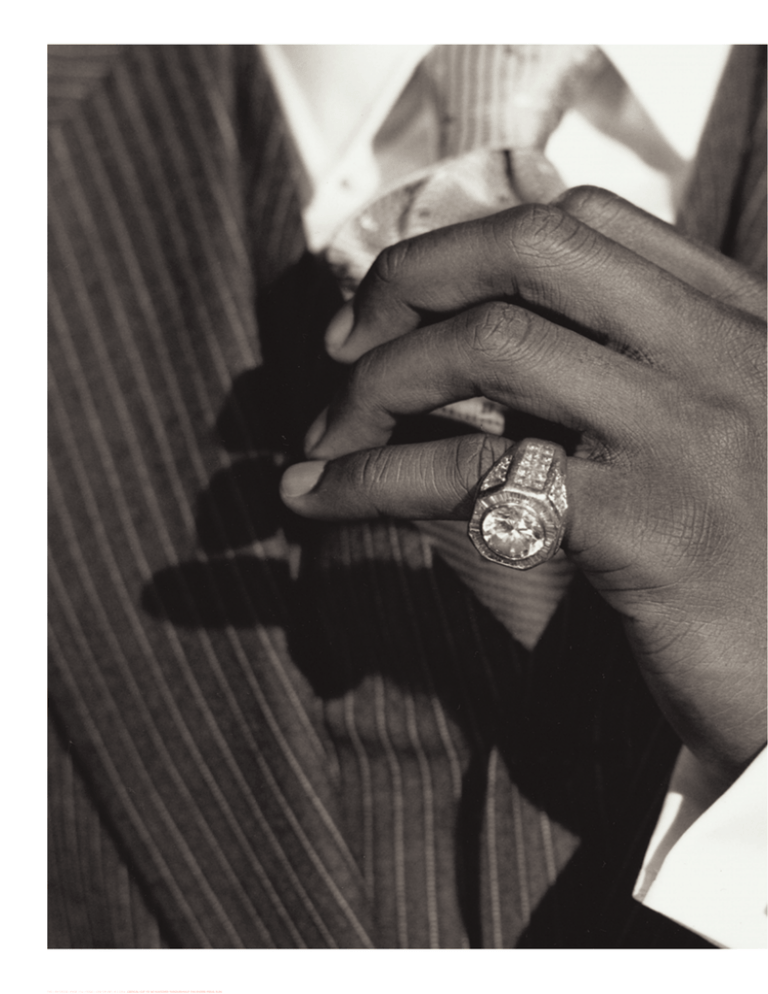
TNY—09/09/02—PAGE 116—133SC.—LIVE OPI ART—R 11294—CRITICAL CUT TO BE WATCHED THROUGHOUT THE ENTIRE PRESS RUN PROFILES I AM FASHION Guess who Puff Daddy wants to be? BY MICHAEL SPECTER T he Air France hostess was pleasant but unwilling to compromise. “This flight closes in three minutes,’’ she said. “We don’t make exceptions.” Chuck Bone, who was sitting in the Concorde’s first-class waiting lounge at J.F.K., reached casually for his cell phone. It was 7:12 A.M. on a Monday in July. The Concorde was scheduled to depart for Paris at eight, and its passengers generally consider even the briefest delay intolerable. Bone, who was wearing a blue-and-white tracksuit and had a simple diamond stud in one ear, started talking. “Where are you guys? You need to get him here now. They are closing the flight.” He listened for a moment and then turned to the woman in charge of the lounge. “He is in the airport,’’ he said. “He’ll be at the terminal in five minutes.’’ The hostess, who was now flanked by three colleagues, was unmoved. “Seven-fifteen and we close it,’’ she said.“I am sorry, but Mr. Puff Daddy must come by then, or he will have to take another plane.’’ Mr. Puff Daddy, the thirty-two-yearold rap impresario, restaurateur, clothing entrepreneur, bon vivant, actor, and Page Six regular—who is also known as P. Diddy, and whose mother calls him Sean John Combs—was expected in Paris within hours. He needed to be on the 8 A.M. flight: it was the first day of fashion week, and Donatella Versace had invited him to sit in the front row at her couture show. Versace’s shows always attract enormous publicity, usually more for the celebrities in the audience than for the models on the runway. The Concorde was Combs’s only hope of making it on time. Jeffrey Tweedy, the vice-president of Combs’s clothing company, Sean John, was in the lounge looking jumpy. He poured himself a cup of tea and took some valerian. He stared unhappily at the oversized Panerai Luminor watch on his wrist. 7:13 A.M. Two minutes to go. A few dozen tastefully dressed men and women with chic handbags and understated accessories began boarding the flight. Still no sign of Combs. For the past three days, he had been in Atlanta, at a music-industry event sponsored by Bad Boy Entertainment, the record company he has run for nearly a decade. There had been a party the final night, and Combs didn’t leave until around four in the morning. He was driven directly to his chartered Gulfstream G4 jet. By 6:30 A.M., he was on the ground at Teterboro Airport, in suburban New Jersey, but the morning traffic on the George Washington Bridge had begun to build. By seven-twenty-five, the passengers in the lounge had checked in and most were already on board. The Air France flight attendants were eager to close the door. One was tapping her foot. Everyone in the Combs entourage—Tweedy; Bone, a friend from high school; Mar Sabado, one of Puffy’s assistants; her boyfriend, a designer in dreadlocks named Emmett Harrell—was on his or her cell phone or working his or her Motorola two-way pager. Sabado was on the phone with Combs’s twenty-eight-yearold chief aide, Norma Augenblick, who was in Paris, making certain that everything was in place for Combs’s arrival at the hotel: champagne in ice buckets; a sufficient supply of Puff Daddy’s favorite tequila (1800); plenty of Cuban cigars, either Monte Cristo No. 2 or Cohiba. Then, there were the racks of clothing to unpack and organize. Puff PHOTOGRAPHS BY HERB RITTS “Fashion is about leaving on your jacket and tie when other people are too hot to bother,” Combs says. TNY—09/09/02—PAGE 117—133SC.—LIVE OPI ART—R 11294—CRITICAL CUT TO BE WATCHED THROUGHOUT THE ENTIRE PRESS RUN—#2 PAGE THE NEW YORKER, SEPTEMBER 9, 2002 117 “Lucky girl—she got one before he was hardwired.” • Daddy does not travel light, and by the time he reached his hotel suite that evening he expected everything to be in order. At seven-thirty, a man in a two-piece white terry-cloth outfit appeared at the far end of the terminal. He was wearing white tennis shoes, white socks, a skintight white terry-cloth hat pulled low over his forehead, and a large diamond ring on his right pinkie. He was walking slowly, and talking rapidly into his cell phone. The hostess wheeled around and left when he approached. He looked tired but clearly pleased to see his friends. He embraced the various members of his crew and then shook my hand. “I hope you are ready to seriously hang out in Paris,’’ he said. “Because don’t come with us if you can’t stay out with us. I fully intend to show Paris the respect it deserves. We are going to rock that place to the ground.’’ His friends clapped once, the way football players do at the end of a huddle. Then they headed for the plane. It was seven-forty. As Combs turned toward the walkway heading onto the Concorde, a security agent gently put a hand on his shoulder and asked him to step aside; after all, even Al Gore gets searched these days. “Mr. Combs,’’ the 118 THE NEW YORKER, SEPTEMBER 9, 2002 TNY—09/09/02—PAGE 118—133SC.—LIVE OPI ART A7708 • guard said. “Would it be possible to get your autograph?” Puff Daddy nodded, pinned his cell phone between his left shoulder and his ear, and, still talking, signed the back of an envelope. “Thank you, sir,’’ the security guard said. “Have a really nice trip.’’ Two minutes before takeoff, a stewardess came over and asked, hesitantly, if Combs might be willing to turn off his phone. He apologized, then snapped it shut. Despite his outsized image, Combs is a not a big man, and he often speaks in a whisper. When he addressed the stewardess, she had to lean in toward the seat to hear him. “I forget how fast this plane travels,’’ he said. “I was trying to explain it to my son before.’’ “Eet eez zee speed of a boullet,’’ the woman replied. “It eez exactly like we are shot out of zee gun.” By the time she had finished describing the velocity of the plane, its cruising altitude, and what happens when the flight breaks the sound barrier, Combs was asleep. W ithin moments of touching down in Paris, Combs and his crew were back on their phones. Puffy, now wide awake, seemed to be having trouble with his, so Tweedy, who was sitting one row behind him, offered some advice: “You have to dial 001 to call a New York cell phone, even if the person is in France,” he explained. Combs whipped around in his seat. “Yo, Jeff, excuse me,’’ he said, in a low, steady voice.“This is my fourteenth Concorde flight. I’m an international fucking player. I’ll tell you how to use a phone.’’ Combs had come to Paris for fun, but it was fun with a purpose. He considers himself (as do many others) among the most fashionable people in the world, and the business of fashion has become an increasingly central part of his life. Sean John, the clothing company he started three years ago, has emerged as one of the best-selling—and most highly regarded—men’s lines in America. Combs’s runway show in New York last fall met with praise from even the most skeptical fashion professionals. “It was better than anything in Europe,’’ Kim Hastreiter, the editor of Paper, the downtown fashion magazine, told me. “It was perfectly presented, perfectly original American fashion.” In 2001, Sean John’s sales, which were thirty million dollars in 1999, rose to nearly two hundred and fifty million. This year, along with Ralph Lauren and Marc Jacobs, Combs was nominated by the Council of Fashion Designers of America as the menswear designer of the year. He introduced his line with the type of T-shirts and baggy jeans that characterize hip-hop clothing brands like FUBU and Eckō, but he quickly graduated to a more sophisticated look, with a modern, slightly off-kilter approach to classic preppy clothes.This month, he will bring out Blue—a more expensive line of denim directed at older customers. Combs and Tweedy also have ambitious plans to enter the lucrative and complicated world of women’s wear, and to open two Sean John stores in New York next year. At a time when many designers are struggling just to stay in business, department stores seem eager for anything Sean John can supply.“Puffy sells second only to Ralph in many of our stores,’’ Kal Ruttenstein, the longtime fashion director of Bloomingdale’s, told me. “Some of that is because of his name, of course. But his clothes are actually quite wonderful, and you would be amazed to see how many types of people wear them.’’ Combs first appeared at the haute- couture shows in Paris five years ago. With his hip-hop credentials and his love of the spotlight, not to mention a past that includes highly public moments of violence, Combs provided exactly what the fashion crowd craves: a frisson of danger without much threat of it. He represented the ultimate expression of nineteen-nineties style: excessive, ironic, and a tiny bit thuggish. He wore fur and leather and draped himself in enough diamonds to rival Princess Caroline of Monaco. Combs made his first visits to the Louvre and to Versailles, which he described to me as “some aweinspiring shit.” He was escorted to many of the shows by Anna Wintour, the editor of Vogue. “Puffy is so wonderfully over the top and flamboyant, and, God, do we need that in our business,’’ Wintour told me. “Fashion goes through severely dull periods and we must have relief. Puff provides it.’’ Donatella Versace, who knows glitz if she knows anything, was counting on Combs’s presence to add some adrenaline to her show. The show was scheduled to begin at eight. At six, Combs was working his way through customs at Charles de Gaulle Airport.The drive into the city would take at least an hour; then he would need to change from his travel clothes into a more fashionable, light-gray, chalkstriped suit, designed by Donatella. He would have to look, in the phrase coined by Andre Harrell, his former boss at Uptown Records, “ghetto fabulous.’’ That meant choosing appropriate accessories: a silver tie, smoke-colored sunglasses, diamond-and-platinum earrings, a bracelet or two, a couple of diamond rings the size of cherry tomatoes, and a watch covered with jewels and worth nearly a million dollars. There is nothing in fashion more deliciously low than a Versace show. The ambience is one of excess, with security guards stationed along the runway and models regularly spilling out of their tops. The show, which was held at the Palais de Chaillot this year, was delayed. Puffy didn’t leave his hotel until eightthirty. He was with Kim Porter, the mother of one of his two children. (She has another child, whom Combs supports and treats as his own.) By the time they arrived, the bleachers were filled: the Hilton sisters, Nicky and Paris, were there, along with their parents, Rick and Kathy. Two of the Miller sisters—Alexandra von Furstenberg and Princess Marie-Chantal of Greece (along with her exiled husband, Crown Prince Pavlos)—were also in the audience. (They are daughters of Robert Miller, the dutyfree billionaire.) These young women are among the dwindling number of people on earth with the means and the desire to pay twenty thousand dollars for a dress they might wear once. Combs and Porter, who was dressed elegantly in black and wore a diamond necklace that, next to Puffy’s jewels, seemed almost demure, were seated beside the actress Elizabeth Hurley, whose floor-length green evening gown was covered with paisley swirls and glittering stars and cut in a remarkably low V. Hurley wore a silver pendant and pink mules. The front row was a spectacle of preening, with Hurley, George Michael, Rupert Everett, David Furnish (Elton John’s lover), the singer Ashanti, and the downtown celebrity actress Chloë Sevigny posing constantly for the cameras. The most photographed guest, by far, was Combs. (People, Us Weekly, and about eight European magazines—many of them named Hello! in a variety of languages—ran pictures of him with Porter, Hurley, or Donatella Versace. “Wow, Puff Daddeee,’’ the photographers screeched. “Mr. Diddeee, can we see the diamonds?”) The fashion show itself lasted about fifteen minutes. Puffy spent much of that time taking pictures of other celebrities with a tiny camera. As soon as the last girl left the runway, he and his friends, led by three security men, went backstage. Versace was having a party at the Ritz Club later that evening, and Puffy would make an appearance, but he still needed to pay his respects to his host. She was surrounded by her staff, some of whom find Combs an unwelcome addition to their world. (“He is like a mezzo Donatella,’’ one of them said to me. “He’s a fashion Mini-Me: half the talent, half the glamour, just as demanding.”) Air kisses were exchanged in the dressing area. “It blew me away,’’ Puff said to Versace, about the collection, which included a patchwork coat made from more than eighty types of antique fabric; a short jacket with blue crocodile skin; and a silver ballgown of antique brocade with a silver lamé skirt. Versace beamed. She wore her peroxided hair straight and long, her lipstick was brown, and her skin was a peculiar shade of gray. Puffy embraced her, and then looked at his assistant Norma and nodded. It was after ten o’clock and, as he put it a few minutes later, he was ready to “escalate.” Norma passed the word to the security detail, and within minutes the entourage was gone. C ombs moves like a candidate for the Presidency. He is always late, he is never alone. (Solitude seems to make him nervous.) Even when he needs to travel a single city block—say, from his Bad Boy offices, in midtown, to the MTV studios, in Times Square— he is loaded into an S.U.V. and driven. This is not purely vanity; Combs has been particularly conscious of security ever since his best friend, the rap star Christopher Wallace, who was better known as the Notorious B.I.G., was gunned down in 1997 in Los Angeles. Combs was with Wallace the night he died, and among his many tattoos there is one on his right wrist, noting B.I.G.’s date of birth and date of death. (The crime, generally attributed to an East Coast–West Coast hip-hop rivalry that also took the life of Tupac Shakur, has never been solved.) The group was whisked into an underground passage and out a back door. There were scores of kids waiting in the street, and when they saw Combs they started screaming, “Pouf Daddeee, Pouf Daddeee!” and quickly surrounded him, seeking autographs. Combs signed them. (Every time he left a restaurant, hotel, or club in Paris, he was delayed by honeymooners, tourists, and other people wanting him to sign an autograph or pose with them for pictures. I never saw him refuse.) Combs wanted to go to the hotel for a drink before heading to Nobu for dinner. After dinner, he went to Versace’s party, and then THE NEW YORKER, SEPTEMBER 9, 2002 TNY—09/09/02—PAGE 119—133SC.—LIVE SPOT ART—18408—PLS INSPECT AND REPORT ON QUALITY 119 to another club, where he remained until dawn. Versace had booked Combs and his entourage into the Hyatt Regency Paris-Madeleine, and he had a suite on the seventh floor, with a separate elevator key. It was a nice hotel, well situated in the center of town. But it was an unusual choice. In Paris, the beautiful people stay at the Ritz or the Plaza Athénée. Many in the fashion crowd prefer the intimacy of the Hotel Côstes. Nobody stays at the Hyatt. (The second night he was in Paris, Puffy visited Vin Diesel in his suite at the Plaza Athénée—a duplex decorated in white, with a large terrace off the bedroom—and he quickly saw what he was missing. “Norma, we need to stay here,’’ Puffy announced. “Time for a change. Get me a room like this.” Norma had anticipated this whim, but the Plaza is always full during fashion week, and there was nothing she could do.) Not that the Hyatt was a hardship: the suite had a baby-grand piano and a large terrace. There were several garment racks in the living room, with more than a dozen suits, scores of shirts, leather jackets, what appeared to be twenty or so belts, and twice as many ties. There were enough shoes to last a lifetime, and enough sneakers to outfit the Knicks. Some of the clothes had been provided by Versace, but most had been flown over from New York. “Can you possibly wear all this in four days?’’ I asked Combs. “All I can do is try,’’ he replied, with a wink. Sunglasses had been arranged in three rows on a high table next to a couch in the living room. There were about ten pairs in each row; each pair was in its original case, with the top flipped up. It looked like the optical counter at Bergdorf ’s. We walked onto the terrace. Montmartre and at least a dozen church steeples stood out against the pale sky. Despite the hour, it was still light. A thin wafer of a moon hung above the city. Emmett and Bone were sitting with Tweedy, sipping wine, taking in the view. Combs, who often seems uneasy in a crowd unless he is performing, stood self-consciously on the edge of the terrace. “Before we get on our way, I just want to say one thing,” he said. “We are in Paris and we are here to learn from one another. We are going to philosophize and improvise and improve each 120 THE NEW YORKER, SEPTEMBER 9, 2002 TNY—09/09/02—PAGE 120—133SC.—#2 PAGE other’s minds. God gave us the chance to be together in this wonderful place and we are going to profit from it. I want to drink mimosas at the Eiffel Tower at dawn. I want us to have fun. But we have to be together to do it. You will not leave me and I will not leave you, and we will have the total experience.” (Combs never seems still. Even when he’s sitting alone in a corner, he pays attention to everything going on around him.) Within minutes, we were off to Nobu, where the Hilton girls and many models, designers, fashion editors, and a few hangers-on were having dinner. After several seating configurations proved untenable, Combs got the waiters to join three tables, and then he ordered approximately two of everything on the menu. When the waiter finished reading back the order, Puffy told him to bring champagne, wine, and two bottles of tequila.“But it has to be 1800 tequila,’’ he said.“And bring it to the table. I want to see the labels.” D inner ended around twelve-thirty. The Versace party was already under way. By the time we arrived at the Ritz Club, a long line had formed, and the bouncers were on edge. Inside, Chloë Sevigny sat on a bench, posing for photographers, and Liz Hurley was playing blackjack with Versace. Despite their presence, it was an oddly B-list crowd, made up mostly of unknown models, publicists, and Versace’s own employees. The Hiltons were there, but they are at every party. At one-thirty, Puffy and his friends packed themselves back into their cars and took off in search of better music and cooler people. They found both. The place, near the Marais, was sweltering and crowded. Waves of hip-hop music rolled across the dance floor. The Nelly song “Hot in Herre” was playing. It was the song of the summer, and, despite the heat, nobody wanted to remain seated. Soon after Combs arrived, the d.j. shouted out the obligatory greeting—“P. Diddy’s in the house!”—and then played Puffy’s No. 1 song “I Need a Girl (Part 1).” Most people assume that the song is about Combs’s relationship with Jennifer Lopez: “Every time I think about your pretty smile, and how we used to drive the whole city wild, damn I wish you would’ve had my child, a pretty lit- tle girl with Diddy’s style.’’ Few couples since Richard Burton and Elizabeth Taylor have appeared more often in the gossip columns. While Combs and Lopez were together, it was as if two corporations, AOL and Time Warner, say, had merged; as much as anything else, they were a marketing phenomenon. When I asked whether “I Need a Girl” was, in fact, about Lopez, Combs laughed ruefully, then shook his head. “It’s a fucking song, man. Would you ask a writer if his book is real or fiction? It’s just a song.’’ Gwen Stefani appeared on the edge of the dance floor. In the echo chamber of the fashion world, Stefani is currently among the most adored of celebrities. Puff was thrilled to see her. He grabbed her by the leg and gracefully swung her around so that her head nearly dipped to the floor, then he reached for her foot and slowly caressed it. At that point, he turned to me and started to sort of rap:“I am fashion because I live fashion,’’ he said. It was so hot in the club that it was difficult to breathe, but Puffy was still wearing his suit, and not one button was undone. His tie was so tightly knotted it seemed to put a strain on his Adam’s apple. A diamond stud was planted in each earlobe. A thick rope of a diamond bracelet—from Jacob, the New York jeweller to the hip-hop élite—adorned his wrist. He said, “From my manicure to my pedicure, from my head to my toe, it’s the swagger that I show the world, it’s my face, baby. It’s my walk, my attitude.’’ He rubbed the wisps of hair on his chin. “Fashion is about leaving on your jacket and tie when other people are too hot to bother.” He was also wearing a yellow diamond ring, which looked like a piece of rock candy.“Details, baby. It’s all about the details. Look at the arm. The ring. The watch. Look at my canary-yellow diamond. Impeccable. Admit it, I am impeccable.” He let out a wolf howl, and dozens of dancers started to cheer. At this point, Norma, who is keenly protective, and who, depending on the hour, is a corporate executive, an accountant, a fixer, a party planner, or a high-end concierge, shouted across the floor to me, “This is all off the record, it’s off the record!” Combs waved her away.“I don’t want this off the record. I’ve got a lot of shit to say about fashion. It don’t really matter what you Clothes from the Sean John autumn collection. Combs, center, says,“It’s the swagger that I show the world, it’s my face, baby.” TNY—09/09/02—PAGE 121—133SC.—LIVE OPI ART—R 11294FNL—CRITICAL CUT TO BE WATCHED THROUGHOUT THE ENTIRE PRESS RUN write about me. Because I’ll still be a fashion god, no matter what.’’ Puff walked to a table where his friends were sipping Cristal and eating strawberries. (“I don’t even drink the shit,’’ he told me. “They bring it wherever I am. It’s a cliché.’’) He plunged his arm into a bucket of ice water. Then he waved it in my face. “Look at that ring,’’ he shouted. “Look at the way it glistens. I am a damn fashionable motherfucker, and I’m not ashamed to admit it.” P uff Daddy believes that he inherited some of his fashion sense from his father. “People say we have a similar approach to fashion,” he told me one day. “They say he was the fliest man around. But he died when I was three. I saw a couple pictures of him, and that was all.’’ Combs’s father, Melvin, spent many years as a limousine driver, and his mother, Janice, told him that his father had died “in his car.’’ That was true, but Melvin Combs didn’t die in an accident; he was a drug dealer, and one night in 1972 he was shot dead in his car in Central Park. Combs’s mother raised Sean and his younger sister, Keisha, alone, working three jobs—as a school-bus driver, a teacher at a local day-care center, and an attendant for children with cerebral palsy—while her mother watched the children. (Combs and his mother still speak to or see each other several times a week; his sister works for him at Bad Boy; and one of his tattoos is dedicated to his grandmother, who died in 1994.) When Combs was ten, he spent a summer with the Amish in Pennsylvania Dutch country, through the Fresh Air Fund. Not long after that, the family moved to Mount Vernon, where Sean attended Catholic schools. He graduated from Mount St. Michael Academy, in the Bronx. Even as a boy, Combs was exceptionally driven. Although he has been called the “black Sinatra,’’ his early role models were closer to the president of the 4-H club than to the coolest kid in school. “He came home one day and told me he wanted to start a paper route,’’ his mother recalled when I went to see her at her apartment overlooking the Hudson. “That is how he started. He always wanted to work and make his money. We had a Cadillac car and a house, and “I had a hat.” TNY—09/09/02—PAGE 122—133SC.—LIVE OPI ART A7241_RD—#2 PAGE he liked life like that,’’ she told me. “Of course, he loves clothes. I do, too. I always made things nice in my house. I’m a fashionable-type person. My husband was a fantastic dresser. It seems to have worn off.” Combs attended Howard University—“the black Harvard,” his mother called it. But he was obsessed with music, and was committed to a career as a producer. He begged Andre Harrell, who was then the president of Uptown Records and now runs Motown, for a job as an intern. Harrell didn’t have much to lose—interns come free—and he was soon amazed by Puffy’s capacity for work. Combs took the train from Washington to New York every week to work for Harrell; before long, he dropped out of Howard, moved into Harrell’s house, and became the first (and last) teen-age division head at Uptown.“I wanted to get my hustle on,” Combs says. His decision to leave school still bothers his mother. “I really was so disappointed about that,’’ Janice told me. “A person works day and night just to educate a kid, and to be able to have a roof over your head and a school uniform. He was a fine student, and when he left college it was hard for me.’’ Although newspapers like to run pictures of Combs on a jet ski in SaintTropez, most of the time if you want to find him you would have better luck calling his office at Bad Boy than checking out the club scene. But no hip-hop musician has successfully positioned himself as a workaholic with a Catholic education who grew up in the suburbs. So Combs found a way to be hipper than anyone as commercial as he is, and to be more commercial than anyone as hip. It has proved to be a remarkably successful formula in music and in clothing. Combs made a name for himself as an energetic club kid who danced in a couple of music videos; by the early nineties, when he was in his twenties, he was a cheerleader for the life of excess that characterized the time. It was an insane era that would see Yahoo! become worth more than General Motors. From the start, Combs was criticized as a mediocre and derivative rapper. That assessment has not changed, although his 1997 record “No Way Out” sold more than seven million copies and won two Grammys. It is as a talent scout, packager, and creator of deals that he has met with true success. His first act, Jodeci, sold seven million records. Since then, Combs has produced the work of Mary J. Blige, Faith Evans, and many others. More important, though, he discovered Christopher Wallace, a former crack dealer who rapped as the Notorious B.I.G. By 1997, the year B.I.G. was murdered, his albums,“Ready to Die” and “Life After Death,” which drew a chilling, nihilistic portrait of life for an urban black man, had turned him into one of the seminal voices of the decade. Combs’s career has been punctuated by violence. In 1991, he and the rapper Heavy D, among others, promoted an AIDS benefit at City College; too many tickets were sold, there was a stampede, and nine people were crushed to death. In 1999, he and two others were arrested for beating a rival record-company executive in his offices at Interscope Records (with a chair, a telephone, and a champagne bottle). Although Combs was asked only to pay the executive a fine and take a one-day anger-management course, his image suffered badly; street toughs didn’t respect him, and his middleclass fans were appalled. Then, just after midnight on December 27, 1999, Combs was involved in an incident at a Manhattan night club, in which three people were shot. He fled with Jennifer Lopez in a Lincoln Navigator, but he was arrested and charged with gun possession and attempting to bribe his driver into taking the rap for him. After seven weeks of testimony, covered by New York’s press as if it were Watergate, Combs was acquitted of all charges. The verdict was broadcast live on the networks. The lowest point of Combs’s career, though, came after the death of his friend Biggie. Combs was depressed for months, and his mother told me that she had been worried for his life. When I asked Combs whether he felt that he had seen more than his share of violence, he said, “Nearly every black man faces an unacceptable level of violence in this society. I’m not different. Money can shield you; it can protect you. But it doesn’t make you white.” Eventually, Combs recovered. His tribute to Biggie,“I’ll Be Missing You,” a remake of an eighties hit by the Police, won a Grammy, and re- “Are you kidding? I’d kill to have your warts.” • mained at the top of the charts for twenty-eight weeks. It became his signature song. It also helped inaugurate a commercial boom in hip-hop that lasted until the end of the nineties. That boom is over. Last year, only two of the top twenty-five pop CDs were recorded by rappers: Ja Rule and Nelly. Neither ranked among the top fifteen albums. Hip-hop fashion has, of course, always been tied to the music market. In the early eighties, kids in baggy jeans started listening to Grandmaster Flash and spray-painting their signatures on subway cars. A few years later, in reaction to the emerging marriage of music and fashion, Run-DMC positioned themselves as anti-glamour authentics (“Calvin Klein’s no friend of mine /don’t want nobody’s name on my behind”). Around that time, the clothing line FUBU—“For Us By Us”—was created, so that minority people could wear clothes designed by minorities. By the nineties, though, rappers like the Notorious B.I.G. had embraced the culture of brand names; even their socks bore labels. “I put my hoes in N.Y. onto DKNY, Miami, D.C., prefer Versace,’’ Biggie rapped on “Hypnotize” in 1997. “Every cutie wit a booty want a Coogi.” Early hip-hop clothing lines were not much different from vanity license plates; they were mostly about promot- • ing the image of the star, not about fashion, per se; you can see Russell Simmons’s affection for argyle vests, for example, in Phat Farm, or the Wu-Tang Clan’s love of oversized T-shirts in Wu Wear. And, early on, Puffy sent sequins and lots of fur onto the runway. (Puffy loves fur; people still talk about his burgundy ostrich trenchcoat with the sheared-mink lining.) If hip-hop music falters in the marketplace, will its fashion also be in danger? Several people told me that Combs was passé.“We don’t listen to his music,’’ a white Manhattan teen-ager who is a particular follower of rap told me. “And nobody I know would buy his clothes.” One of New York’s best-known fashion editors put it more baldly:“Oh, my God, Puffy is sooo two years ago.’’ But such criticism misses the point. Combs has never really wanted to be the hippest guy in the room; he wants to be the hippest successful guy in the room. He told me that his fashion and business idols are Ralph Lauren and Martha Stewart—two self-invented characters whose deft re-creations of America, real and imagined, have made their fortunes. “Those are the templates,’’ he said. “When you look at what they have accomplished, it’s magnificent.” It is not surprising that he wants to leap out of the world of hip-hop, with its fetishizaTHE NEW YORKER, SEPTEMBER 9, 2002 TNY—09/09/02—PAGE 123—133SC.—LIVE OPI ART A7341—#2 PAGE 123 tion of Gucci and Fendi, and into the world of Ralph Lauren and Martha Stewart. “Here I think Puffy is very interesting,” Kelefa Sanneh, who has written extensively about hip-hop and pop culture, told me. “You can see him shift away from the aspirational approach of the nineties. He is not a great rapper, or even a great producer. But he goes out and scoops up new beats and talent. In clothes, he seems to be doing the same thing. He is a mogul, and he is moving with the market.” Ralph Lauren and Martha Stewart are more than brands; they offer visions of the world. Where Lauren presents an ersatz interpretation of the suburban dream life, Stewart has turned the middle-class hearth and home into an industry. Puffy hopes to dignify the urban life and package it for people who may never have entered a city. He has managed to market his clothes to kids who are tutored for the E.R.B.s and the S.A.T.s. He is becoming to the street what Ralph Lauren is to Waspiness and Martha Stewart is to the ideal of the American homemaker. And Combs’s empire continues to grow as rapidly as ever.“The thing I love about Puff is that he comes back,’’ his assistant Norma told me. “After B.I.G. died, people thought he would go right down the toilet—then he put out a No. 1 album. During the trial, Jennifer dumped him, they said his music career was over, he would be going to prison—and even if he got off he would be through. Well, guess what? He has a best-selling record, he’s a happy father, his clothing company absolutely rocks. Puffy will always come back. He’s like nature.” D uring his trial, Combs worked on his collection; most nights after court, he sat with Tweedy and the design team and sketched out ideas. He would talk through a notion, and the designers would attempt to translate it into patterns, which he would evaluate. He told me that he founded Sean John because the clothes he saw bored him. “I felt there was a total lack of something,” he said. “Fashion was dull, dead. I thought maybe we could bring in some life.” He never saw the clothes he designed as solely an extension of his hip-hop persona; rather, he regards his place in 124 THE NEW YORKER, SEPTEMBER 9, 2002 TNY—09/09/02—PAGE 124—133SC. ORCHID Now that you are gone, you are everywhere. Take this orchid, for instance, its swollen lip, the scrawny stalk’s one descended testicle as wrinkled as rhetoric on the bar-scene stump, the golden years since jingling in its purse. How else signal the bee? In my swan-clip now languish urgent appeals from the usual charities lined up to be ignored. But your flags are up: I see the flapping petals, the whorl of sepals, their grinning come-on. Always game, again I’d head straight for the column’s sweet trap. Ducking under the puckered anther cap to glide toward the stiff, waxy sense of things, where male and female hardly matter to one’s heady urge to pull back the glistening lobes and penetrate the heart, I fell for it every time, the sticky bead laid down on my back as I huddled there with whatever—mimicking enemy or friend, the molecular musk of each a triggering lure— wanted the most of me. Can I leave now, too? I have death’s dust-seed on me. I have it from touching you. —J. D. McClatchy hip-hop culture as a forum for selling clothes. One day not long ago, I walked around the Sean John boutique at Bloomingdale’s. I saw clothes simple and sophisticated enough to please Jil Sander. When you first look at them, the clothes seem as if they belonged at Brooks Brothers or Paul Stuart. Then you notice the lavender and mustard cardigans, the shiny mother-of-pearl buttons and the bold stitching on the coats. Sean John pants are sharply tailored, the textures are rich, and the buyers are often men in their thirties hoping to look cool. Combs hired Jeffrey Tweedy, a former Ralph Lauren executive, as vicepresident of his company. Tweedy, a dapper black man who grew up in Washington, D.C., got his first job stocking clothes at Britches of Georgetown. He sees or talks to Combs three or four times a day. “I was a little leery at first,’’ he told me. “I thought, Whoa, what did I need with a celebrity cat who wanted to start yet another label? But the more I talked to him the more I realized he was completely able to do this. He is totally involved, yet willing to let people do their jobs.” Sean John is now sold in more than twelve hundred stores. The company, while not yet competitive with Tommy Hilfiger or Ralph Lauren, has easily surpassed its competitors in the urban fashion market, FUBU, Phat Farm, and Eckō. “We design for a hip young guy,” Tweedy told me. “Loves clothing, very stylish, and has a bit of disposable income—not for a teen-ager but for a man who aspires to wear Gucci one day and Prada one day and to be able to afford the custom Zegna suits. Now, down the road we will try to develop a life-style brand. That’s the goal.’’ As a fashion figure, Combs has transcended hip-hop completely. He has done more: black fashion has been ripped off and reinterpreted for many years, and Combs has helped take it back from the Tommy Hilfigers of the world. “There is this clear dialectic—it’s sort of like jazz,’’ Kim Hastreiter, of Paper, told me. “White designers forever would go to 125th Street to see what was happening. That is where they got their inspiration, their cool.Then the blacks turned that upside down. They took the icons of the rich and suburban and blasted them. This is when sweatshirts with the word ‘Harvard’ printed on them a hundred times emerged; the ghetto was making fun of the suburbs, and if the suburbs were about Mercedeses then the kids in the ghetto would wear a necklace with the word ‘Mercedes’ in block capitals.’’ After the most recent Sean John runway show, Hastreiter wrote, in Paper, “He threw bling bling out the window and sent out a low-key, gorgeous readyto-wear collection. This stuff could stand up to anything, anywhere in the world today.’’ The company has moved deliberately but with apparent ease in the marketplace. Some fashion veterans are thrilled by its success and the attention it has brought the industry; others find it hard to believe that a man who doesn’t know how to sew is considered a successful designer. But the significance of Sean John is no longer questioned. One day while I was in Paris, I ran into Richard Buckley, who is the editor of Vogue Hommes International. “I just got an e-mail from this writer who asked me who I thought mattered in men’s clothes these days,” Buckley told me. “I said the only man who is doing anything important is Puff Daddy. Right now, he is all we got.” artificially enhanced strippers disrobing on the bar, and the music. (In Paris, some of the women smoked Gauloises instead of Marlboro Lights.) Men wear gray, and women wear black. They all carry tiny digital cameras and minuscule dualband cell phones. The party began around midnight, but there were many stops to make first. Puffy’s days in Paris started late—he tended to go to bed about 9 A.M. and sleep till early in the afternoon. If there was time, he would work out—he was travelling with a trainer, a stylist, and at least two personal assistants—before beginning to think about the evening’s plans. (In New York, he sleeps about four hours a night, and makes only occasional visits to clubs.) This night, Anna Wintour was giving a party to celebrate the publication of a book by Grace Coddington, Vogue’s longtime creative director. Afterward, there was to be a dinner at Karl Lagerfeld’s eighteenth-century mansion. Oddly, though Puffy had been invited, he was a no-show. I met him and his friends around 11 P.M. at a restaurant down the street from the Plaza Athénée. Usually chatty and solicitous, he was sulking. Norma had somehow marooned him at a restaurant where there was no 1800 tequila. By the time I showed up, she was working two cell phones, trying to repair the damage. She called the Hyatt, but it had none; she struck out at the Ritz, too. It was nearly midnight, and Puff ’s party was about to begin. Bijou Phillips, who was making a film in Luxembourg with Madeleine Stowe and had arrived in Paris that day, tried to help. “How do you say ‘eight’ in French?” she asked. “If we could just tell him the number in French, maybe he would have it.’’ Combs had also just been made aware that he had forgotten to attend the Anna Wintour party. “How the fuck could something like that happen?” he asked Norma, who offered no excuses. She put her head in her hands, then ordered roses to be sent to Wintour’s hotel. Wintour has been among Combs’s most vigorous supporters, and he was beside himself at the notion that he might have offended her. In the middle of dinner, he decided to go to the bar of the Plaza Athénée, down the street, and abruptly got up and left. The bar was crowded with débutantes, models, actors, and rock stars, most of them transplanted from Manhattan. “I’m with Puffy,’’ Paris Hilton said to her friend Cornelia Guest. You could feel the thrill pass between them. (I had asked Norma if Puffy was, in fact, friendly with the Hilton sisters or the Miller girls. “Not friendly, exactly,’’ she replied. “But there are really only two types of rich people—the ones who go out, and the ones who don’t. The Hiltons go out.”) Suddenly, there was a brief confrontation at the bar. Naomi Campbell had just arrived, and she and T he second night of his stay in Paris, Puff Daddy threw a bash at Les Bains Douches, the former municipal bath that has been among Paris’s most popular clubs for more than a decade. The party could have been in SaintTropez, New York, L.A., or East Hampton: the crowd, the food, the highly paid, TNY—09/09/02—PAGE 125—133SC.—LIVE OPI ART #A7378—#2 PAGE “What about accessories?” Bijou Phillips were calling each other names. Phillips bumped into Campbell, and Campbell wheeled around and screamed,“I could knock you out, Bijou.” The word “bitch” bounced back and forth like a Ping-Pong ball. There was some suggestion that Campbell, who is even more unpleasant than she is alluring, had hit on Phillips’s fiancé, Sean Lennon, earlier in the summer. Combs, who has a gift for conciliation that has served him well as a producer, walked over, put his arm around Phillips, and gently pulled her away. B lack cars were lined up for blocks around Les Bains Douches by the time Puffy arrived. The party was so crowded that even people clutching invitations were having trouble getting in; the Hiltons (accompanied by their parents), the Miller sisters, Ivana Trump, Tom Ford, Mick Jagger, Eva Herzigova, Vin Diesel, and Bijou Phillips were all there. Jagger, sipping on a Heineken, looked rumpled. Combs’s principal action was to issue whistles to most of the people in the house and to stand in a corner, stomp his feet, and clap along with the writhing dancers. He ordered five bottles of Cristal, four of Veuve Clicquot, two of Absolut, and two of 1800 tequila, with enough Coke to wash it down. He was dressed casually, in white linen without a jacket or tie. A diamond crucifix dangled from his neck. Tom Ford was having a drink at the bar when we entered. Puff started to walk over to him, then came back and grabbed me by the wrist and pulled me along. “You got to come with me for this, dawg,’’ he said. As Combs approached, Ford held out his hand, but Puff Daddy got down on his knees and started an “I’m not worthy” wave at him. Ford laughed uncomfortably. “You are my god,’’ Combs told him. “I worship you.” Hundreds of people had packed into the narrow old club. Puffy and his crowd had sequestered themselves in a cordoned-off area near the entrance. Everyone could see them, but only the chosen could approach. The group consisted of Puffy, Kim Porter, the rest of Puffy’s visiting friends, Vin Diesel, the Hiltons, and Ivana Trump. Not long after 2 A.M., Puff handed a whistle to Ivana, and she spent much of the next hour blowing it. By that time, the Hilton girls were on a tabletop, dancing. So was their mother, Kathy. “I feel so bad for Paris,’’ Bijou Phillips said as she watched Kathy Hilton wriggling.“Can you imagine how mortified she is watching her own mother acting like that?” The “My summer vacation: How I made money in a bear market.” TNY—09/09/02—PAGE 126—133SC.—LIVE OPI ART #A7820 d.j. dedicated the Sheila E. song “The Glamorous Life” to Puff. “This is for P. Diddy,’’ he said, using the most current version of his name. (During a particularly searching interview after Combs’s trial last year, he announced that from now on he would be referred to not as Puff Daddy but as P. Diddy, which is what Biggie called him. He meant it partly as a joke. The next day, to his astonishment, the news was on the front page of the Post.) By 4:30 A.M., the party was winding down. Only the core group remained, dancing to Chaka Khan and some old Prince tunes. At about five, when it looked as though the evening might be over, Combs turned to me and said, “We are going to a strip club, and we are all going together.” As soon as he finished speaking and climbed into his car, Norma turned to me and mouthed the words,“Totally off the record.” Then we left. After breezing by two bouncers, we descended through a tunnel with video screens in the floor and walls. Hip-hop music played in the background. Puffy took a seat next to the catwalk where the girls “work.” He insisted that I sit next to him. “Let’s do an interview,’’ he said. It was 5:15 A.M. and he finally felt relaxed enough to answer questions. Next to us, there was a spectacularly gifted woman at work. She had started off in a latex catwoman suit but was now wearing only an elaborate mask, a G-string, and a pair of stilettos. “Look at this woman,’’ Puffy said. “Jesus. Do you think she’s French?” (He wanted to tip her, but he rarely carries money. He waved for Norma, but she was across the noisy room.) I reminded him that Norma had decreed that the trip was off the record.“Nothing in my life is off the record,’’ he said. “I wish it was, but it isn’t. Never has been.’’ I asked if he enjoys his celebrity. “Of course,’’ he said. “I hate rich people who complain about how tough it is being rich. They are insane. I pay, like, fiftyper-cent taxes and I am very proud of that. I would happily pay more.’’ I asked him if Sean John was as important to him as music, and if he got pleasure out of the clothes. “It’s different from music. I don’t mix the two. What I do mix is life style. I am making a life style, and it’s part of entertainment. This just seems to be an obvious expression of who I am.’’ “Does the clothing line need to make money for you to be satisfied with it?” I asked. “Fuck, yes,’’ he said, taken aback by the question. “I want people to know how serious we are and what we are capable of doing. And I want to be known as a businessman who made something better, made my people happy, and had some fun.” It was past dawn, nearly 6 A.M. “How did you feel about Jennifer Lopez leaving you the way she did?’’ I asked. Lopez had left him in the midst of the trial after the night-club shooting, when it seemed as if his musical empire, along with his self-made persona, were about to come crashing down. “Well, you know, I wish her the best in her life. I always have,’’ he said. “But . . .” His voice trailed off. “Look, if she is happy, then I am happy for her.’’ One of his friends had been listening.“Disloyal bitch,’’ the friend said. “She’s nothing but a disloyal bitch.” T he following night, Puffy was invited to a small gathering at Karl Lagerfeld’s mansion. Norma made sure he didn’t forget this party. “Go,’’ she told him. “Just get up and go.” We were having a late dinner (with Puffy, there is no other kind) in the Buddha Bar, around the corner from the Hotel Crillon, and, as Combs and Porter were leaving, he decided to buy her some Buddha Bar souvenirs. (In recent months, Combs and Porter have spent considerable time together. When I asked him about it, he said, “I don’t really know where it will go.”) He dropped the souvenirs on the counter and spelled out the name “N-O-R-M-A” to the woman behind the register. Then he placed an international cell-phone call to Norma—who was finishing her dinner about a hundred feet away—and told her to pick up Porter’s gifts when she was done. Puffy was in an expansive mood as his limousine sped through the nearly empty streets of Paris. “This city is so fly,’’ he said. “Look at the clocks and the windows and the lights. And those little Smart cars. Even the buses are cool. Can you find a speck of dirt or any garbage on the ground? It’s amazing. These people have the food, the clothes, the love. This city is just mad beautiful.” Lagerfeld’s home is in the Sixth Arrondissement, a neighborhood inhabited mostly by rich businessmen and diplomats. His house looked as if it could have served as a pied-à-terre for the Sun King. Occupying twenty acres or so, the hôtel particulier—as the French call such immense city houses—had been lavishly restored over the previous decade to its pre-Revolutionary opulence. A petite woman, dressed in Chanel, opened the door onto a grand hallway where about a dozen people stood talking and smoking cigarettes. Butlers served champagne. The scene looked like a Ralph Lauren ad, down to the women in flowing dresses and chignons, and the sockless men in tuxedos. Pink buds—mainly freesias and roses—lined the hall and the main salon. The only thing missing was a golden retriever. Lagerfeld was completing a latenight fashion shoot. Models whose clothes were too cumbersome to permit them to move unaided were led down a grand marble staircase by walkers, like Thoroughbreds being taken to the gate at the Kentucky Derby. The ball gowns were cut from sheets of silk, lace, and tulle. Several women wore masks. A chandelier draped in pink silk dominated the salon. One of the models, in a black hat that was five feet wide, required two men to guide her, one on each side of the hat. A samba band played briskly while Lagerfeld snapped pictures; every ten minutes or so, an assistant would transfer what he had recorded to a powerful computer in the next room. Puff and Kim looked on in amazement. Lagerfeld seemed pleased to have Puffy in his house—but wasn’t quite sure what to do with him. “Let’s take a tour,’’ he said. And they proceeded to stroll upstairs, where the models were getting dressed.“Good evening, girls,’’ Puffy said politely—before snapping some Polaroids of himself and Porter in the scene. “I hope we are not interrupting.” It isn’t easy to get Puff Daddy to leave a party, but his friends were bored, and they weren’t mixing with many of the other guests. Kim grabbed Puffy and dragged him toward the car. The Hiltons and the Millers and several of their friends needed a ride to the next stop— a birthday party at a club called Cantina. None of the women had a car, so they started to pile in with us, and there just wasn’t room.“Wait,” Puffy’s stylist, a nononsense black woman, yelled. “Them bitches be heiresses. Blond Something von Furstenberg and Hiltons and shit. What are we now, a fucking limo service? They got to be getting their own damn cars.’’ C ombs had many supporters at the Council of Fashion Designers of America award ceremonies—the fashion world’s equivalent of the Oscars— this year. Anna Wintour told me that she was rooting for him, and so did the fashion editors of other magazines. The ceremony was held in the Celeste Bartos Forum of the New York Public Library. By 7 P.M., limousines had started to pull up to the covered runway on Fifth Avenue. Penélope Cruz accompanied Ralph Lauren; Lauren Hutton came next. Puffy was with his mother, Jeff Tweedy, and several members of the Sean John design team. He was the last nominee to arrive. He was dressed conservatively: a simple diamond earring in each ear, the canary-yellow pinky ring, and a subtly patterned black suit. His mother was more elaborately attired: she wore black stiletto slippers, diamond hoop earrings, and a variety of amulets. Her blond hair dangled over bare shoulders. They posed together on the red carpet. “Janice, are you proud of your boy?’’ a television reporter asked. “Yes, I am always proud of Sean,’’ she replied. By the time they swept into the front hall, it was almost empty. Puff strolled through, working his two-way pager and occasionally taking a phone call. Ralph Lauren came out to say hello and Calvin Klein wandered over to tell Janice how lovely she looked. I asked Puffy if he was nervous. We were standing beneath blowups of Jackie Kennedy, Oleg Cassini, and Audrey Hepburn. “No,’’ he replied. “Why be nervous about what you can’t control?’’ It wasn’t until after 11 P.M. that Alan Rickman presented the award for men’s fashion. Puffy stopped sending e-mail and making phone calls. After a brief video display of each man’s work, Rickman announced that the award would go to Marc Jacobs. Puffy applauded loudly, smiled at everyone, and then picked up his phone. Tweedy sighed. When we got up to leave, I asked Combs how he felt about losing. He shrugged.“Hey, I didn’t lose,’’ he said.“I was nominated. I am just getting started.” ♦ THE NEW YORKER, SEPTEMBER 9, 2002 TNY—09/09/02—PAGE 127—133SC. 127
